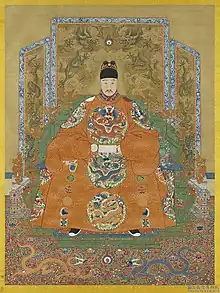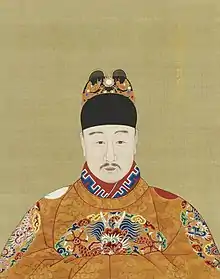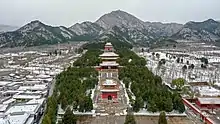Longqing Emperor
The Longqing Emperor (simplified Chinese: 隆庆帝; traditional Chinese: 隆慶帝; pinyin: Lóngqìng Dì; 4 March 1537 – 5 July 1572), personal name Zhu Zaiji (朱載坖),[1] art name Shunzhai (舜齋),[2] was the 13th emperor of the Ming dynasty, reigned from 1567 to 1572. He was initially known as the Prince of Yu (裕王) from 1539 to 1567 before he became the emperor. His era name, "Longqing", means "great celebration".
| Longqing Emperor 隆慶帝 | |||||||||||||||||
|---|---|---|---|---|---|---|---|---|---|---|---|---|---|---|---|---|---|
 | |||||||||||||||||
| Emperor of the Ming dynasty | |||||||||||||||||
| Reign | 4 February 1567 – 5 July 1572 | ||||||||||||||||
| Enthronement | 4 February 1567 | ||||||||||||||||
| Predecessor | Jiajing Emperor | ||||||||||||||||
| Successor | Wanli Emperor | ||||||||||||||||
| Prince of Yu | |||||||||||||||||
| Tenure | March 1539 – 23 January 1567 | ||||||||||||||||
| Born | 4 March 1537 Jiajing 16, 23rd day of the 1st month (嘉靖十六年正月二十三日) | ||||||||||||||||
| Died | 5 July 1572 (aged 35) Longqing 6, 26th day of the 5th month (隆慶六年五月二十六日) | ||||||||||||||||
| Burial | Zhaoling Mausoleum, Ming tombs, Beijing | ||||||||||||||||
| Consorts | |||||||||||||||||
| Issue |
| ||||||||||||||||
| |||||||||||||||||
| House | Zhu | ||||||||||||||||
| Dynasty | Ming | ||||||||||||||||
| Father | Jiajing Emperor | ||||||||||||||||
| Mother | Empress Xiaoke | ||||||||||||||||
Reign

After the death of the Jiajing Emperor, the Longqing Emperor inherited a country in disarray after years of mismanagement and corruption. Realizing the depth of chaos his father's long reign had caused, the Longqing Emperor set about reforming the government by re-employing talented officials previously banished by his father, such as Hai Rui. He also purged the government of corrupt officials namely Daoist priests whom the Jiajing Emperor had favoured in the hope of improving the situation in the empire. Furthermore, the Longqing Emperor restarted trade with other empires in Europe, Africa and other parts of Asia. Territorial security was reinforced through the appointment of several generals to patrol both land and sea borders. This included the fortification of seaports along the Zhejiang and Fujian coast to deter pirates, a constant nuisance during the Jiajing Emperor's reign. The Longqing Emperor also repulsed the Mongol army of Altan Khan, who had penetrated the Great Wall and reached as far as Beijing. A peace treaty to trade horses for silk was signed with the Mongols shortly thereafter.
The Longqing Emperor's reign, not unlike that of any previous Ming emperor, saw a heavy reliance on court eunuchs. One particular eunuch, Meng Cong (孟沖), who was introduced by the Longqing Emperor's chancellor Gao Gong, came to dominate the inner court towards the end of the emperor's reign. Despite initial hopeful beginnings, the Longqing Emperor quickly abandoned his duties as a ruler and set about pursuing personal enjoyment, much to the disappointment of the reform-minded advisors.[3] The emperor also made contradictory decisions by re-employing Daoist priests that he himself had banned at the start of his reign.
In October 1567, Xu Jie firmly told the Emperor to stop eunuchs supervising the capital training divisions.[4] Enraged, Longqing said "I ordered eunuchs to sit with the training divisions, and the speaking officials objected, and you all objected too. What's the idea? Explain your disobedience."[4] Xu Jie explained that the Jiajing Emperor had abolished eunuch-run divisions and that the founder never set up eunuchs to run divisions.[4] Longqing backed down for now.
Death

The Longqing Emperor died in 1572 at the age of 35. At the time the country was still in decline due to corruption in the ruling class. Before the Longqing Emperor died, he had instructed minister Zhang Juzheng to oversee affairs of state and become the dedicated advisor to the Wanli Emperor who was only 10.
The Longqing Emperor was buried in Zhaoling (昭陵) of the Ming tombs.
Legacy
.jpg.webp)
.jpg.webp)
The Longqing Emperor's reign lasted a mere five years and was succeeded by his son. It was said that the emperor also suffered from speech impairment which caused him to stutter and stammer when speaking in public.[5] He is generally considered one of the more liberal and open-minded emperors of the Ming dynasty, even though he lacked the talent keenly needed for rulership and he eventually became more interested in pursuing personal gratification rather than ruling itself.
Family
Consorts and Issue:
- Empress Xiaoyizhuang, of the Li clan (孝懿莊皇后 李氏; d. 1558)
- Zhu Yiyi, Crown Prince Xianhuai (憲懷皇太子 朱翊釴; 15 October 1555 – 11 May 1559), first son
- Zhu Yiling, Prince Dao of Jing (靖悼王 朱翊鈴), second son
- Princess Penglai (蓬萊公主; 1557), first daughter
- Empress Xiao'an, of the Chen clan (孝安皇后 陳氏; d. 1596)
- Princess Taihe (太和公主; d. 1560), second daughter
- Empress Dowager Xiaoding, of the Li clan (孝定皇太后 李氏; 1545 – 18 March 1614)
- Zhu Yijun, the Wanli Emperor (神宗 朱翊鈞; 4 September 1563 – 18 August 1620), third son
- Princess Shouyang (壽陽公主; 1565–1590), personal name Yao’e (堯娥), third daughter
- Married Hou Gongchen (侯拱辰) in 1581
- Princess Yongning (永寧公主; 11 March 1567 – 22 July 1594), personal name Yaoying (堯媖), fourth daughter
- Married Liang Bangrui (梁邦瑞; d. 9 May 1582) in 1582
- Zhu Yiliu, Prince Jian of Lu (潞簡王 朱翊鏐; 3 March 1568 – 4 July 1614), fourth son
- Princess Rui'an (瑞安公主; 1569–1629), personal name Yaoyuan (堯媛), fifth daughter
- Married Wan Wei (萬煒; d. 1644) in 1585, and had issue (one son)
- Consort Duanjingshu, of the Qin clan (端靜淑妃 秦氏)
- Princess Qixia (棲霞公主; 1571–1572), personal name Yaolu (堯𡞱), seventh daughter
- Consort Gonghuizhuang, of the Liu clan (恭惠莊妃 劉氏; d. 1582)
- Consort Zhuangxirong, of the Wang clan (莊僖榮妃 王氏; d. 1580)
- Consort De, of the Li clan (李德妃 李氏; d. 1632)
- Consort Duan, of the Dong clan (端妃 董氏)
- Consort Hui, of the Ma clan (惠妃 馬氏)
- Consort He, of the Zhao clan (和妃 趙氏; d. 1581)
- Consort An, of the Yang clan (安妃 楊氏; d. 1576)
- Consort Rong, of the Han clan (容妃 韓氏; d. 11 September 1630)
- Consort Jing, of the Zhuang clan (敬妃 莊氏; d. 1580)
- Consort Zhaoronggong, of the Li clan (昭榮恭妃 李氏)
- Consort Yi, of the Yu clan (懿妃 於氏)
- Consort Qi, of the Ye clan (奇妃 葉氏; d. 1621)
- Consort Xian, of the Jiang clan (賢妃 江氏)
- Consort Gong, of the Wu clan (恭妃 吳氏)
- Consort Jing, of the Qi clan (敬妃 齊氏)
- Consort Ying, of the Xu clan (英妃 許氏)
- Consort An, of the Qian clan (安妃 錢氏)
- Unknown
- Princess Yanqing (延慶公主; b. 1570), personal name Yaoji (堯姬), sixth daughter
- Married Wang Bing (王昺) in 1587
- Princess Yanqing (延慶公主; b. 1570), personal name Yaoji (堯姬), sixth daughter
Ancestry
| Emperor Yingzong of Ming (1427–1464) | |||||||||||||||||||
| Chenghua Emperor (1447–1487) | |||||||||||||||||||
| Empress Xiaosu (1430–1504) | |||||||||||||||||||
| Zhu Youyuan (1476–1519) | |||||||||||||||||||
| Shao Lin | |||||||||||||||||||
| Empress Xiaohui (d. 1522) | |||||||||||||||||||
| Lady Yang | |||||||||||||||||||
| Jiajing Emperor (1507–1567) | |||||||||||||||||||
| Jiang Xing | |||||||||||||||||||
| Jiang Xiao | |||||||||||||||||||
| Empress Cixiaoxian (d. 1538) | |||||||||||||||||||
| Lady Wu | |||||||||||||||||||
| Longqing Emperor (1537–1572) | |||||||||||||||||||
| Du Lin | |||||||||||||||||||
| Empress Xiaoke (d. 1554) | |||||||||||||||||||
See also
References
- 《明世宗實錄》卷二百:上命皇第三子名載坖,第四子名載圳。上親告太廟。《皇明詔令》卷二十一<立皇太子並封二王詔>:立朕元子載𡓝為皇太子,分封第二子載坖為裕王,第三子載圳為景王。《弇山堂別集》萬曆十八年金陵刻本:穆宗莊皇帝諱載坖。《名山藏》卷二十九<典謨記>:穆宗皇帝御諱載坖,世宗皇帝第三子也《罪惟錄》卷十二:嘉靖十六年丁酉春正月,皇第三子生,名載坖。《國朝獻徵錄》所載<陳以勤墓志銘>:乃生而命名,從元從土。若曰:首出九域。君意也。
- (Ming) Shen Defu (沈德符). Compilation of Wanli era catastrophes (萬曆野獲編), Volume 1: "又云世宗號堯齋,其後穆宗號舜齋。"
- Frederick W. Mote (1999). Imperial China, 900-1800. Harvard University Press. p. 727. ISBN 9780674012127.
- Dardess, John W. (25 September 2013). A Political Life in Ming China: A Grand Secretary and His Times. Rowman & Littlefield. p. 179. ISBN 9781442223783.
- Mote, Frederick W. (2003). Imperial China 900–1800. Cambridge: Harvard University Press. p. 725. ISBN 0-674-01212-7.